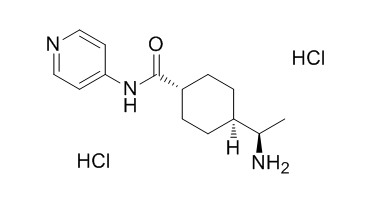Y-27632 2HCl
Y-27632 2HCl is a selective ROCK1 (p160ROCK) inhibitor with Ki of 140 nM in a cell-free assay, exhibits >200-fold selectivity over other kinases, including PKC, cAMP-dependent protein kinase, MLCK and PAK.
Inquire / Order:
manager@chemfaces.com
Technical Inquiries:
service@chemfaces.com
Tel:
+86-27-84237783
Fax:
+86-27-84254680
Address:
1 Building, No. 83, CheCheng Rd., Wuhan Economic and Technological Development Zone, Wuhan, Hubei 430056, PRC
Providing storage is as stated on the product vial and the vial is kept tightly sealed, the product can be stored for up to
24 months(2-8C).
Wherever possible, you should prepare and use solutions on the same day. However, if you need to make up stock solutions in advance, we recommend that you store the solution as aliquots in tightly sealed vials at -20C. Generally, these will be useable for up to two weeks. Before use, and prior to opening the vial we recommend that you allow your product to equilibrate to room temperature for at least 1 hour.
Need more advice on solubility, usage and handling? Please email to: service@chemfaces.com
The packaging of the product may have turned upside down during transportation, resulting in the natural compounds adhering to the neck or cap of the vial. take the vial out of its packaging and gently shake to let the compounds fall to the bottom of the vial. for liquid products, centrifuge at 200-500 RPM to gather the liquid at the bottom of the vial. try to avoid loss or contamination during handling.
Sci Rep.2024, 14(1):3684.
J. Pharm. Biomed. Anal.2024, 245:116193.
Microchemical Journal2023, 194:109249
J Inflamm Res.2022, 15:5347-5359.
Acta horticulturae2017, 1158:257-268
LWT2021, 138:110630.
Fitoterapia.2024, 175:105955.
Front Plant Sci.2024, 15:1458916.
J Chromatogr A.2022, 1685:463640.
Nutrients.2024, 16(14):2267.
Related and Featured Products
Nat Med, 1999, 5(2), 221-225.
An essential part for Rho-associated kinase in the transcellular invasion of tumor cells.[Pubmed:
9930872]
Adhesion of tumor cells to host cell layers and subsequent transcellular migration are pivotal steps in cancer invasion and metastasis. The small GTPase Rho controls cell adhesion and motility through reorganization of the actin cytoskeleton and regulation of actomyosin contractility.
METHODS AND RESULTS:
Cultured rat MM1 hepatoma cells migrate through a mesothelial cell monolayer in vitro in a serum-dependent, Rho-mediated manners. Among several proteins isolated as putative target molecules of Rho, the ROCK (ROK) family of Rho-associated serine-threonine protein kinases are thought to participate in the induction of focal adhesions and stress fibers in cultured cells, and to mediate calcium sensitization of smooth muscle contraction by enhancing phosphorylation of the regulatory light chain of myosin. Transfection of MM1 cells with cDNA encoding a dominant active mutant of ROCK conferred invasive activity independently of serum and Rho. In contrast, expression of a dominant negative, kinase-defective ROCK mutant substantially attenuated the invasive phenotype. A specific ROCK inhibitor (Y-27632) blocked both Rho-mediated activation of actomyosin and invasive activity of these cells. Furthermore, continuous delivery of this inhibitor using osmotic pumps considerably reduced the dissemination of MM1 cells implanted into the peritoneal cavity of syngeneic rats.
CONCLUSIONS:
These results indicate that ROCK plays an essential part in tumor cell invasion, and demonstrate its potential as a therapeutic target for the prevention of cancer invasion and metastasis.
Neuron, 2000 May;26(2):431-41.
A critical role for a Rho-associated kinase, p160ROCK, in determining axon outgrowth in mammalian CNS neurons.[Pubmed:
9930872]
METHODS AND RESULTS:
We tested the contribution of the small GTPase Rho and its downstream target p160ROCK during the early stages of axon formation in cultured cerebellar granule neurons. p160ROCK inhibition, presumably by reducing the stability of the cortical actin network, triggered immediate outgrowth of membrane ruffles and filopodia, followed by the generation of initial growth cone-ike membrane domains from which axonal processes arose. Furthermore, a potentiation in both the size and the motility of growth cones was evident, though the overall axon elongation rate remained stable. Conversely, overexpression of dominant active forms of Rho or ROCK was suggested to prevent initiation of axon outgrowth.
CONCLUSIONS:
Taken together, our data indicate a novel role for the Rho/ROCK pathway as a gate critical for the initiation of axon outgrowth and the control of growth cone dynamics.
Nature,1997 Oct 30;389(6654):990-4.
Calcium sensitization of smooth muscle mediated by a Rho-associated protein kinase in hypertension.[Pubmed:
9353125]
Animal Models: Male Wistar rats with spontaneous or induced hypertension; Swiss albino mice with Ehrlich ascites carcinoma
Dosages:30 mg/kg/day (Rat); 0-10 mg/kg (mice)
Administration: Orally (Rat); i.p. (Mice)



